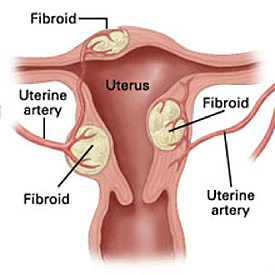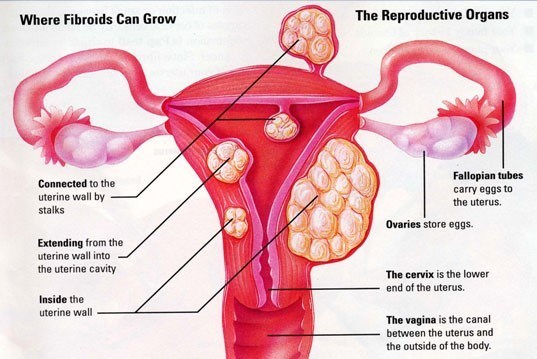FIBROIDS TREATMENT & CARE AT JFC
A non-cancerous (benign) tumor that grows from the muscle layers of the woman’s womb, Fibroids are also growths of smooth muscle and can vary from the size of a bean to as large as a melon.
Also called as Uterine Fibroids or Myomas, Fibroids is estimated to affect nearly 20% of all women at some point of their lives (that is 1 in 5 women)

WHO IS AFFECTED THE MOST?
- Women of reproductive age.
- Women who are overweight and obese.
FIBROIDS – ITS TYPES, CAUSES, AND ALL THAT
TYPES OF FIBROIDS
Four types of Fibroids exist, based upon their location in the Uterus. They include:
- INTRAMURAL: Located in the wall of the Uterus. It is said to be the most common type.
- SUBSEROSAL: Located outside the wall of the Uterus, but underneath the tissue layer that surrounds the Uterus. It is said that they can develop into pedunculated Fibroids (Called Stalks) and become pretty large in shape.
- SUBMUCOSAL: Located in the muscle beneath the lining of the Uterus wall. It is said that it can protrude into the cavity of the woman’s Uterus.
- CERVICAL: Located in the neck of the woman’s womb (Called the Cervix).
CAUSES OF FIBROIDS
In reality, medical experts have so far not been able to a common consensus about why Fibroids occur.
However they point out that it could occur due to:
- Heredity factor; woman whose close relatives have had Fibroids.
- Nulliparous
Also during a woman’s reproductive years, Estrogen and Progesterone levels are pretty high, and when they are high especially during pregnancy, then Fibroids may shrink. This could happen during a woman’s menopause.
SYMPTOMS OF FIBROIDS

The symptoms of Fibroids depend on the location and size of the tumor(s) and how many tumors a woman has.
- Heavy bleeding between or during woman’s periods that includes blood clots.
- Pain in the woman’s pelvis and/or woman’s lower back.
- Increased menstrual cramping.
- Increased urination.
- Pain during sexual-intercourse.
- Menstruation that lasts longer than usual.
- Pressure or fullness in woman’s lower abdomen.
- Swelling or enlargement of the woman’s abdomen.
They could also include Backache, Constipation and Anemia.
In case the tumor’s size is small, or if the woman is going through menopause, then she is said to have had no symptoms. It must be noted that Fibroids may shrink during and after menopause.
Uterine Fibroids Removal Treatment in Hyderabad
DIAGNOSIS OF FIBROIDS
To begin with the symptoms of Fibroids are rarely felt and the woman patient does not have any idea whether she has them. They are usually discovered during the woman’s vaginal examination.
- ULTRASOUND SCAN: It can detect them and eliminate other possible conditions which may have similar symptoms. They are said to better visualise cervical and submucosal types of Fibroids.
- MRI SCAN: Said to be the best type of imaging that can determine Fibroids size and whether there are multiple Fibroids in the woman’s Uterus.
- HYSEROSCOPY: A small telescope that examines the inside of the woman’s Uterus. If required, a biopsy (small tissue sample) can be taken of the uterus’s lining.
- LAPAROSCOPY: A small flexible tube used to examine the outside of the woman’s Uterus. If required, a biopsy can be taken from the outer layer of the woman’s Uterus.
TREATMENTS FOR FIBROIDS
In case the woman has no symptoms and the Fibroids are not affecting her daily life, then no treatment is recommended. This applies to those women as well who have had heavy periods but whose lives are unaffected by symptoms.
When it comes to treatment, doctors at Juhi Fertility Centre prescribe them in the form of medication or surgery.
MEDICATIONS
- GnRHA (gonadotropin): It releases hormone agonist which makes the woman’s body produce much lower quantities of estrogen, which in turn will shrink the fibroids. GnRHA stops the woman’s menstrual cycle but does not affect the woman’s fertility once the treatment stops.
- ANTI-INFLAMMATORY DRUGS: It includes mefenamic and ibuprofen which reduces the production of prostaglandins, which are normally associated with heavy periods. They do not affect fertility.
- CONTRACEPTIVE PILL: An oral contraceptive pill helps regulate the woman’s ovulation cycle and also help reduce heavy menstrual bleeding associated with Fibroids when the woman is in her periods.
- LNG-IUS (Levonorgestrel intrauterine system): A plastic device that is placed inside the woman’s uterus where LNH-IUS releases levonorgestrel (progestogen hormone) which helps to stop the lining of the uterus from growing too fast and also helps reduce bleeding.
SURGERY TO TREAT FIBROIDS AT JUHI FERTILITY CENTRE
Doctors at Juhi Fertility Centre (JFC), based on the woman’s symptoms and whether medical therapy has failed, recommend surgery.
The choice based on the woman’s specific condition can be any one from the following:
- HYSTEROSCOPY: Where the woman has Fibroids that is very large or is bleeding too much, the remedy is through surgery to remove the woman’s uterus. They are also recommended in cases to prevent to comeback of Fibroids.
- MYOMECTOMY: It helps to surgically remove the Fibroids from the wall of the woman’s uterus. This is an option wherein the woman would want to get pregnant. However where the woman has large Fibroids or Fibroids that are located in particular parts of her uterus, then this treatment is not recommended as it does not benefit.
- ENDOMETRIAL ABLATION: It helps remove the lining of the woman’s uterus. It is recommended wherein the woman’s Fibroids are near the inner-surface of the woman’s uterus.
- Uterine Artery Embolization (UAE): It helps cut off the woman’s Fibroids blood supply, thereby effectively shrinking the Fibroid.
- MAGENTIC-RESONANCE-GUIDED PERCUTANEOUS LASER ABLATION: An MRI scan that is used to locate the Fibroids. Under the scan, very fine needles are inserted through the woman’s skin and pushed until they reach the targeted Fibroids.
- MAGENTIC-RESONANCE-GUIDED FOCUSED ULTRASOUND SURGERY: An MRI scan that locates the Fibroids. Under this, sound waves are used to shrink the Fibroids.
The doctor at JFC based on the woman patient’s condition, age, the size of the Fibroids and overall health, develops a treatment plan. It could involve in the end a combination of treatments.

